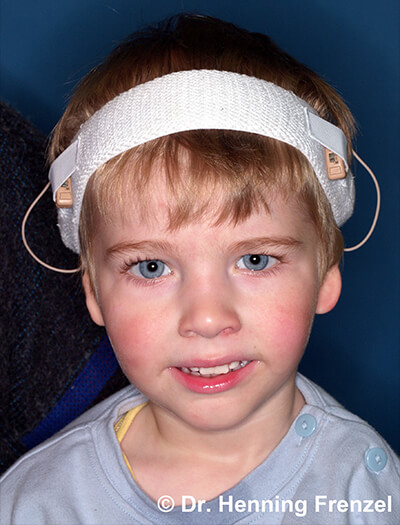Timescale and Diagnosis
Hearing rehabilitation is at the forefront and should occur in every case because speech and general development depend on the ability to hear.
Early Hearing Rehabilitation

The function of the middle and inner ear of children with microtia or atresia must be tested within the first weeks of life by a specialist practice or department in the hospital. This area is called “paediatric audiology”. In the first four years of life children wear a bone conduction hearing device on a headband. These hearing devices pick up sound and convey it via the skull to the inner ear.
Definitive hearing rehabilitation
From the second year of life definitive hearing rehabilitation is possible. The ideal time for treatment depends on the severity of the malformation and the chosen method. Reconstructive surgery on the ear canal and middle ear is possible in selected cases. Furthermore, a range of hearing technology is available. This includes bone conduction hearing aids and implants.
Imaging Methods
There are different methods of examination which involve making images of organs or bones. Computer tomography (CT) in radiology is an example of this. Naturally a radiological examination should only be performed if it is necessary for the treatment. We do not recommend a routine radiological examination straight after birth. A CT scan is necessary before an implant operation, for example. Magnet resonance imaging (MRI), on the other hand, is only used in special cases.
Ear Reconstruction
Many affected persons experience the absence of the auricle as very stressful for their self-esteem and their relationships with other people. But there are just as many affected people who do not experience such a malformation as a restriction and do not want a pinna reconstruction. The decision for or against treatment must be made personally by each patient or family. It is very important to us to discuss these aspects in detail with you in advance.
If you personally decide to have a plastic auricle reconstruction, there are three different methods to perform it: The auricle can be reconstructed with a individual custom-made 3D polyethylene implant or from autologous rib cartilage. Furthermore, artificial auricles, so-called prosthesis, made of silicone are available. These replicate the ear as a whole and are worn on the head by means of magnets.
All three methods have their advantages and disadvantages. We will advise you in detail about them during your consultation.
Syndromes & Further Diagnosis
Microtia and atresia can occur separately or as part of a syndrome. A syndrome is described as different symptoms occurring simultaneously. Known syndromes with ear malformations include Goldenhar syndrome (oculo-auriculo-vertebral dysplasia) and Treacher Collins syndrome (also known as Franceschetti syndrome). In these cases genetic counselling is useful. At the same time the internal organs should be checked for defects in a preliminary paediatric examination. Because these must be treated first in any event.
The eyes, jaw and spine are also probably affected and require examination and treatment as appropriate by a specialist ophthalmologist, oral and maxillofacial surgeon or a paediatric orthopaedic surgeon.



